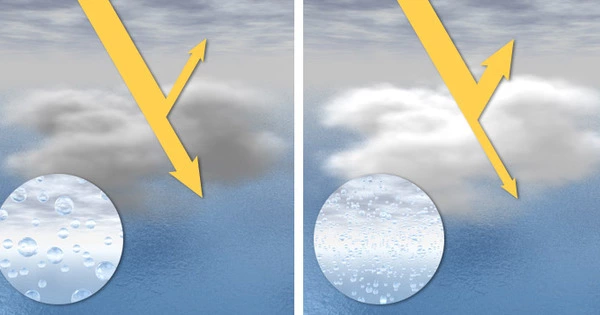According to new research, aerosol particles in the atmosphere have a greater impact on cloud cover but less impact on cloud brightness than previously thought. Aerosols are tiny particles suspended in the atmosphere that play an important role in cloud formation.
Because aerosols are increasing as a result of human activity, numerous assessments by the Intergovernmental Panel on Climate Change (IPCC) have suggested that they could have a significant impact on climate change because clouds reflect sunlight and thus keep temperatures cooler. However, the cooling effect of aerosols on clouds is difficult to quantify, resulting in significant uncertainty in climate change projections.
Clouds are an important part of the Earth’s climate. Clouds block the sun and shade the ground, cooling the planet’s surface and atmosphere. They also trap heat and humidity in the atmosphere, which warms the air. Clouds transport water around the world in the form of moisture and rainfall, influencing climate, vegetation, erosion, and other aspects of our planet. Clouds are extremely complex and one of the major sources of uncertainty in climate and Earth system models. For climate scientists, understanding how clouds form and how they affect weather and climate is critical to understanding our changing world and predicting its future.
According to our findings, the eruption’s aerosols increased cloud cover by about 10%. Based on these findings, we can conclude that increased cloud cover is responsible for more than 60% of the climate cooling effect of cloud-aerosol interactions.
Dr. Ying Chen
The new study led by the University of Exeter, with national and international academic partners and the UK’s Met Office, used the 2014 Icelandic volcano eruption to investigate this.
“This massive aerosol plume in an otherwise near-pristine environment provided an ideal natural experiment to quantify cloud responses to aerosol changes, namely the aerosol’s fingerprint on clouds” said lead author Dr. Ying Chen.
“According to our findings, the eruption’s aerosols increased cloud cover by about 10%. Based on these findings, we can conclude that increased cloud cover is responsible for more than 60% of the climate cooling effect of cloud-aerosol interactions. Volcanic aerosols also brightened clouds by reducing water droplet size, but this had a much smaller impact on reflecting solar radiation than cloud-cover changes.”
Previous models and observations suggested that cloud-aerosol interactions accounted for the majority of the cooling. Water droplets typically form in the atmosphere around aerosol particles, so a higher concentration of these particles facilitates the formation of cloud droplets.
However, because these cloud droplets are smaller and more numerous, the resulting clouds can hold more water before rain falls; thus, more aerosols in the atmosphere can result in more cloud cover but less rain.

The study examined cloud cover and brightness using satellite data and computer learning. It compared the periods before and after the volcano eruption by using 20 years of satellite cloud images from two different satellite platforms in the region. The findings will provide observational evidence of aerosols’ climate impacts, which will help scientists improve the models they use to forecast climate change.
“Our earlier work had shown that model simulations could be used to disentangle the relative contribution of aerosol-cloud-climate impacts and potentially confounding meteorological variability,” said Jim Haywood, Professor of Atmospheric Science at the University of Exeter and a Met Office Research Fellow.
What effect do clouds and aerosols have on climate? Clouds can reflect sunlight, ultraviolet light, and heat away from Earth. This contributes to the stabilization of the Earth’s atmosphere’s temperature. However, clouds can trap heat that is in the air or radiates from the ground. This has the potential to warm the environment. Clouds and climate interact in a variety of ways. Scientists, for example, predict that rising global temperatures will reduce the size and number of clouds in some parts of the world. This would allow more sunlight to reach the ground and warm the atmosphere even more.
Aerosol particles have an impact on the Earth’s climate because they act as the seeds from which clouds form. More aerosol particles can result in a greater number of smaller cloud droplets. This could reduce the amount of rain that falls from that cloud. Aerosol particles, which circulate in the atmosphere, also shape the climate. Some of these particles can reflect sunlight, which helps to keep the atmosphere cool. Other aerosol particles absorb solar heat. As a result, the atmosphere warms. This is particularly true of black carbon. It absorbs a lot of sunlight because it’s black.
“This work is unique in that it does not rely on models; instead, it employs cutting-edge machine learning techniques applied to satellite observations to simulate what the cloud would look like if the aerosols were not present. There are significant differences between predicted and observed cloud properties, which can be used to assess the aerosol-cloud-climate interactions.”
















